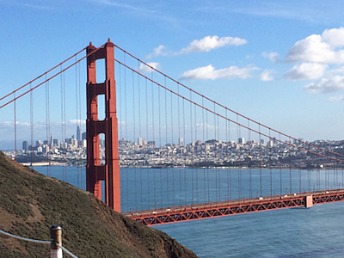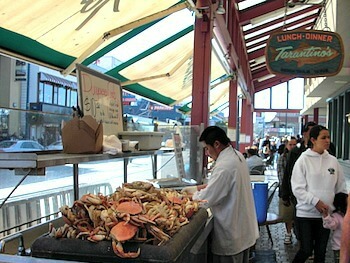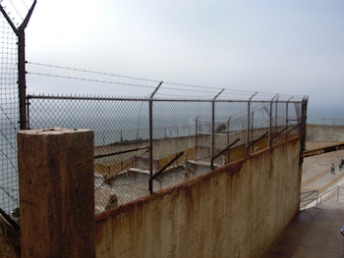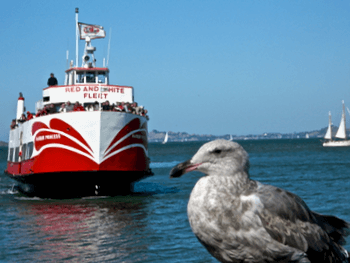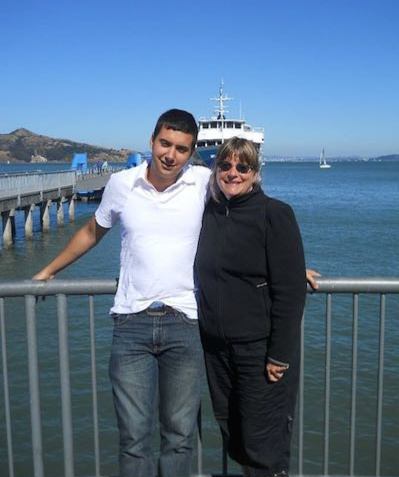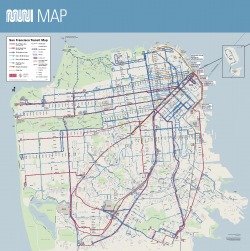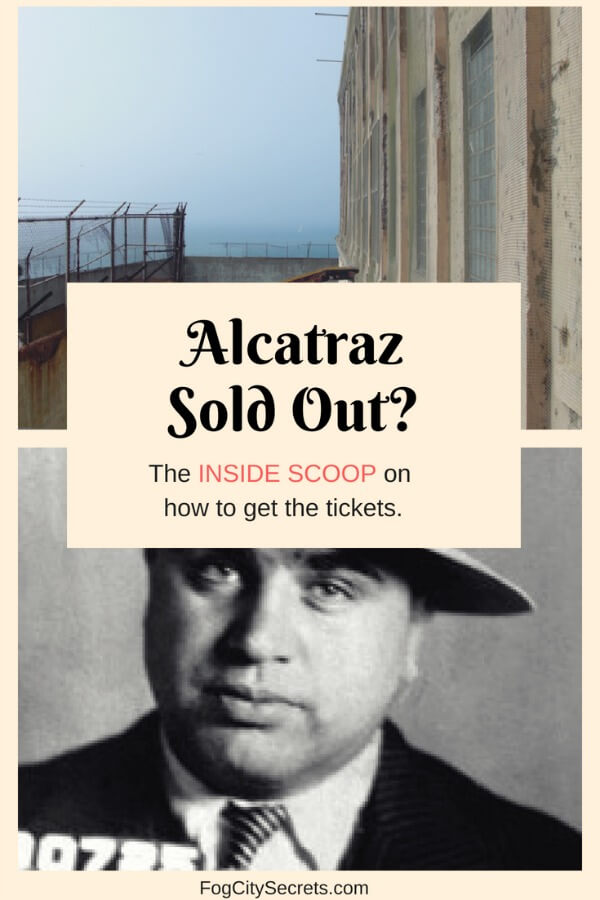- Home
- San Francisco Attractions
- Chinatown
Chinatown San Francisco
Tips from a local...
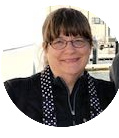
San Francisco's Chinatown is the oldest one in North America and covers 24 city blocks.
This neighborhood is one of the most popular attractions in San Francisco, and for good reason.
You'll really feel you've stepped into another world and another culture.
It's easy to spend a day here, exploring the streets and alleys, browsing the shops and enjoying the authentic Chinese food. More people visit Chinatown than the Golden Gate Bridge!
Here's my collection of the best things to do and see in San Francisco's Chinatown: where to eat, where to shop, and the coolest places to explore.
- Things to do in Chinatown
- Shopping tips
- Best places to eat
- Chinatown history
- Getting to Chinatown
- Walking tours
- Where to park
- Chinatown hotels
- Map of Chinatown
San Francisco's Chinatown is the most densely populated neighborhood west of Manhattan. The residents are almost all Chinese and often speak little English, being fairly recent arrivals.
This is also one of the poorest areas of San Francisco; the median income is around $20,000 a year (vs. around $76,000 city wide). About two-thirds of the residents live in single room, residential hotels.
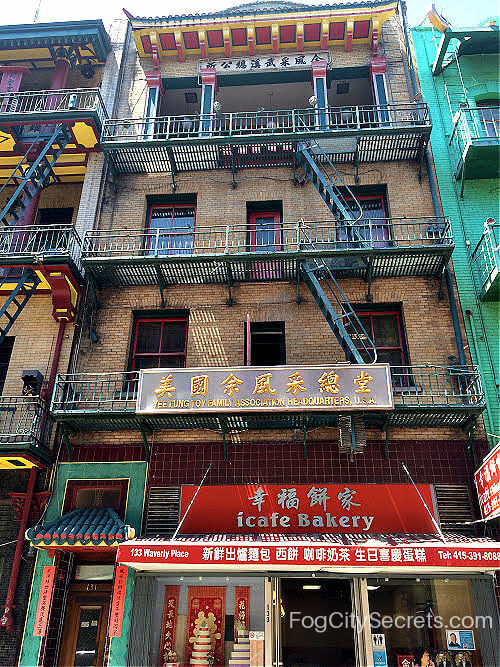 San Francisco Chinatown
San Francisco ChinatownThings to Do in Chinatown
People explore Chinatown in different ways. Many visitors stick to Grant Avenue, the picturesque tourist street, where most of the shops are.
Others wander into the many interesting side streets and little alleys where the more authentic life of the community goes on. Best way? Do both!
What are the best things to see and do in Chinatown? Here are my recommendations:
The Chinatown Gate.
This much-photographed Dragon Gate is the official entrance into Chinatown on Bush Street, where Grant Avenue takes you into the heart of Chinatown. Auspicious dragons and koi fish decorate the gate, and two stone lions stand guard.
The gate is an authentic entry gate like those seen in Chinese towns, and was a gift from Taiwan in 1969. The quote in Chinese from Dr. Sun Yat Sen (founder of the Chinese Republic) says "All under heaven is for the good of the people".
The Dragon Gate is right near Union Square, a good place to begin your exploration of the neighborhood.
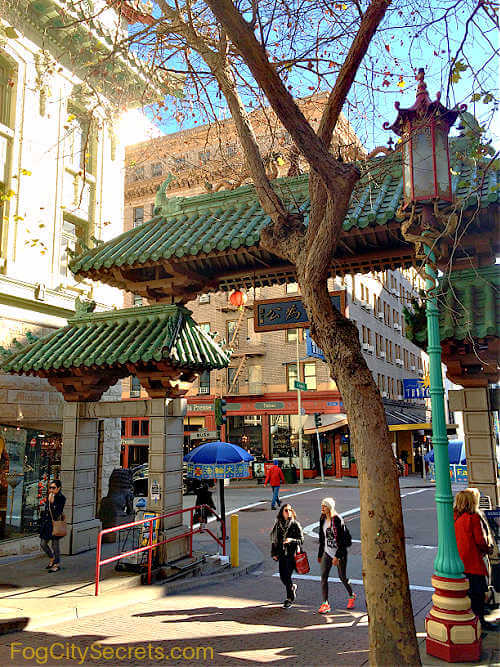 The Dragon Gate
The Dragon GateGrant Avenue
Grant Avenue runs the length of Chinatown; many of the tourist-oriented businesses are located here.
It's pretty in a kitschy sort of way, with Chinese lamp posts, lots of red lanterns, and buildings with Chinese-style, decorative flourishes. It's a pleasant street to stroll down; this is where most of the gift shops are.
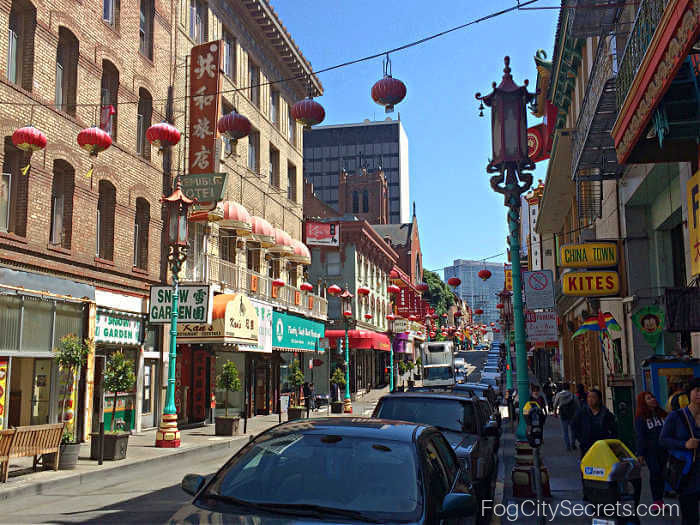 Grant Avenue
Grant AvenueSing Chong and Sing Fat
These two buildings facing each other at the intersection of Grant and California were the first ones built in Chinatown after the earthquake in 1906.
They were quickly built to head off plans to move Chinatown to a less desirable area, and were designed in a Chinese style with a view to attracting tourists to the neighborhood (it worked, on both counts!).
The California Cable Car line runs past them. Get off here to explore the neighborhood.
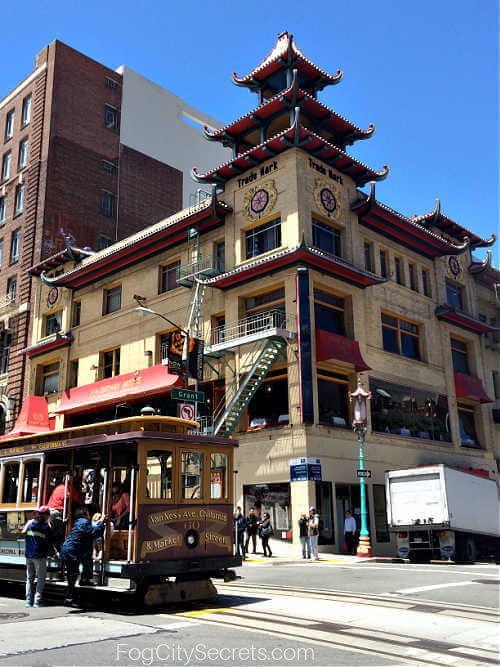 Sing Chong Building
Sing Chong BuildingChinatown Shops
There is a great variety of shopping opportunities here, from bargains to higher-end items. Even if you're not looking to buy anything, it's fun to browse.
Most of the gift shops are on Grant Avenue, with the produce markets on Stockton Street, but be sure to wander off the main streets to explore the side streets and alleys.
For more info, see my page on the most interesting shops in Chinatown.
Stockton Street
Stockton Street is where the Chinese residents of the district shop. The street runs parallel to Grant Avenue, just one block uphill. The prices are lower and the atmosphere is authentically China.
Stockton Street is an intense immersion into another culture; the produce markets are fun to explore, though the animal markets that can be difficult for Westerners to see. You really feel you have left the U.S. and stepped into a foreign land.
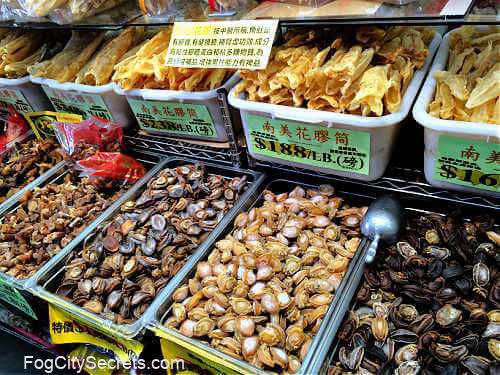 Seafood Market, Stockton Street
Seafood Market, Stockton StreetChinatown Murals
Chinatown is full of colorful murals to admire as you're exploring.
Here's one on Grant Avenue near the Canton Bazaar:
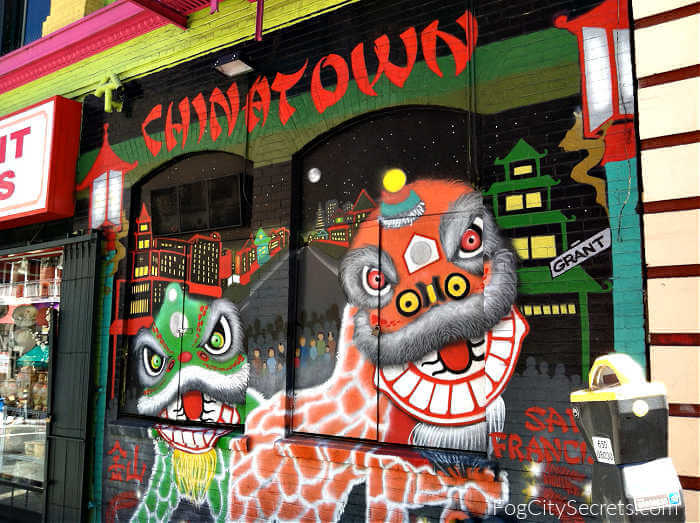
You'll see more along here and on the side streets.
Chinese Herbal Shops
Herbal shops in this neighborhood supply residents and visitors with a vast array of Chinese herbs, as well as having Chinese doctors on hand to diagnose aliments and recommend remedies.
One of the oldest and most interesting is the Great China Herb Company, at 857 Washington, with the original wooden counters and cubby holes.
Tea Tasting
Tea tasting is a relatively new addition to Chinatown. This is a fun thing to do; the presentation of the tea preparation is interesting and the staff is very knowledgeable about the varieties of tea available.
Vital Tea Leaf is a respected tea company and has three shops (509, 905, and 1044 Grant Ave.) that do tastings, with no pressure to buy.
We really enjoyed the experience, and came away with some tasty tea!
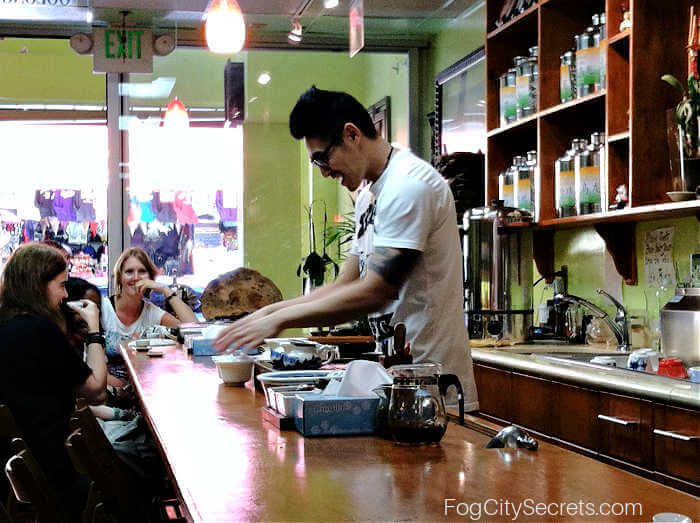 Vital Leaf Tea Tasting
Vital Leaf Tea TastingOld St. Mary's Church
Old St. Mary's Church was built in 1853 and is the only building to survive the fire that destroyed Chinatown after the 1906 earthquake.
It has been beautifully restored and you can see the fire damage on many of the bricks outside (called clinker bricks). The bricks were brought to San Francisco by ship around the tip of South America.
Under the clock reads a warning (from Ecclesiastes) aimed at men tempted by the many brothels that used to be in this area: "Son, observe the time and fly from evil."
Corner of Grant and California.
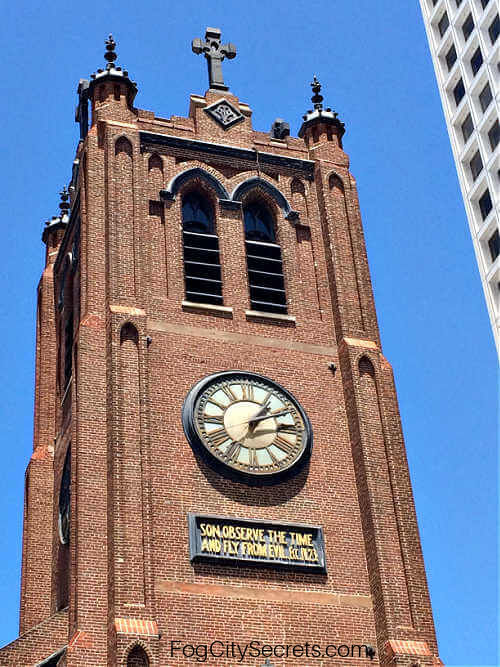 "Son, Observe the Time"
"Son, Observe the Time"Old Telephone Exchange
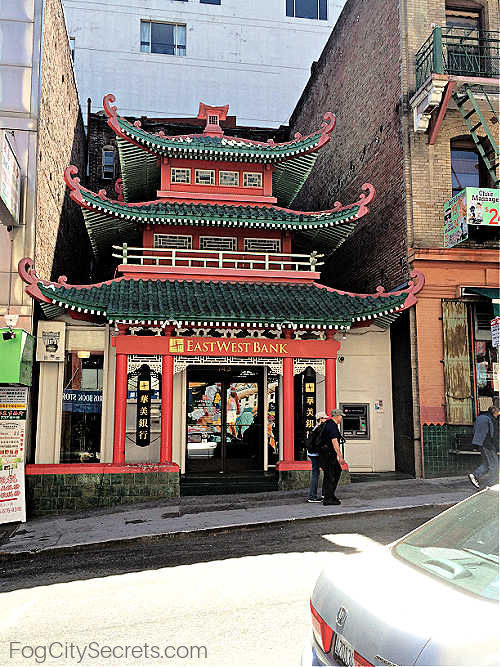 Old Chinatown Telephone Exchange
Old Chinatown Telephone ExchangeFormerly the Bank of Canton, now the East West Bank, this used to be the Chinese Telephone Exchange.
Chinese women operated a switchboard where they had to know the names and numbers of every resident of Chinatown (and speak Cantonese, Mandarin and English).
743 Washington St.
Portsmouth Square
Portsmouth Square is where the city of San Francisco got it's start. The first houses were built here, and Captain Montgomery raised the American flag here in 1846, claiming the area for the United States.
This was one block from the bay at the time and was the port and town center during the Gold Rush days. At Kearny and Clay Streets.
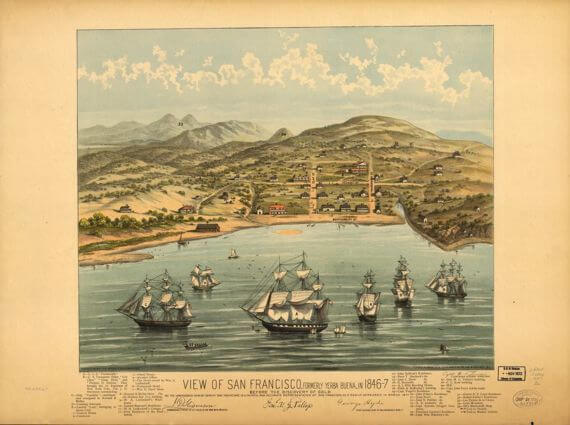 View of Portsmouth Square in 1846
View of Portsmouth Square in 1846Robert Louis Stevenson, author of Treasure Island, used to sit and write in this square during the year he lived in San Francisco, and there's a plaque dedicated to him here.
Also, a large, bronze replica of the Goddess of Democracy is located in the square.
Now Portsmouth Square is the center of Chinatown, and a favorite spot for tai chi and Chinese chess games by the residents.
It's not a particularly attractive square but it played a major role in San Francisco history.
A convenient parking garage is right underneath the square.
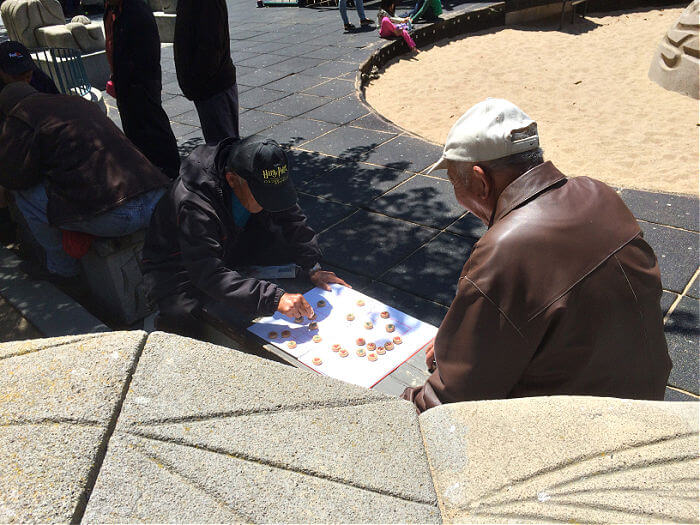 Chinese Chess in Portsmouth Square
Chinese Chess in Portsmouth SquareThe Transamerica Pyramid Redwood Grove
The Transamerica Building (hard to miss) is one block from Portsmouth Square, and has a pretty park with 60 redwood trees right behind it.
The Montgomery Block, a well-known, 19th-century building, used to be on this spot. Some famous names used to hang out here: Mark Twain, Bret Harte, Ambrose Bierce and Robert Louis Stevenson.
Now there's a cool fountain with leaping frogs (in Twain's honor, from "The Celebrated Jumping Frog of Calaveras County" short story) and a charming sculpture of children playing.
This area used to be under water before it was filled in with dirt and the hulls of ships abandoned in the bay during the Gold Rush. Montgomery Street was the wharf area then.
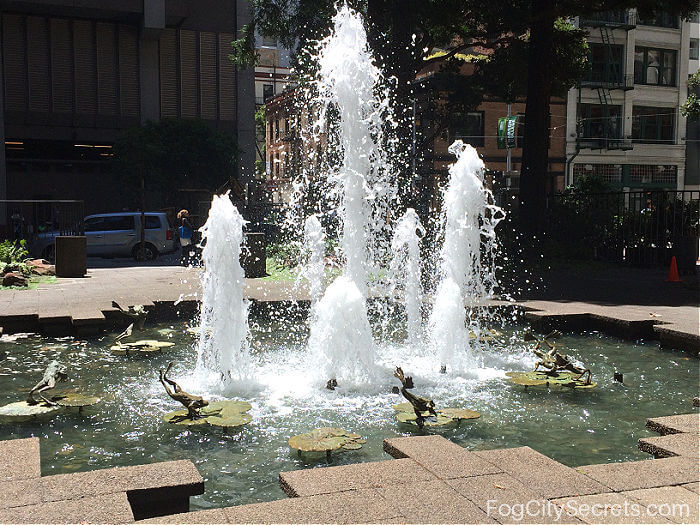 Transamerica Redwood Grove Park
Transamerica Redwood Grove ParkThe Chinese Historical Society
The Chinese Historical Society is a museum and cultural center that hosts exhibits relating to the experience of the Chinese in San Francisco.
The building is the former Chinatown YMCA, designed by architect Julia Morgan. Closed Mondays.
965 Clay Street.
See current exhibits.
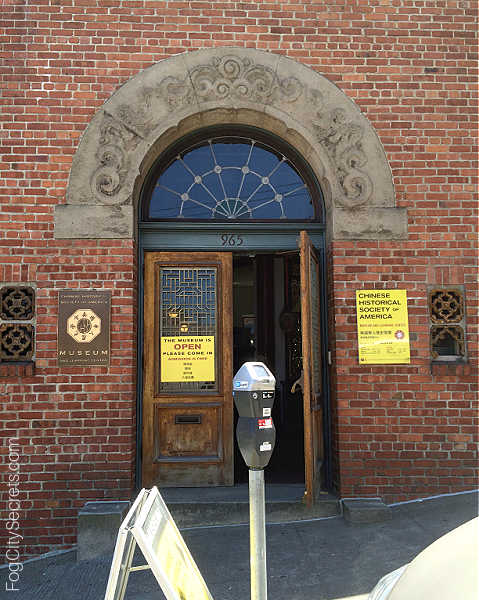 Chinese Historical Society Museum
Chinese Historical Society MuseumThe Chinatown Alleys
The Chinatown Alleys are the most appealing part of Chinatown, IMO.
Getting off the main artery of Grant Avenue and exploring the little side streets will give you a more authentic look at the culture.
This is where much of the life of this community occurs, with little shops, mah jong parlors, hanging laundry, etc. Travel to China without a passport!
During the late 1800's and early 1900's, the alleys of Chinatown were notorious for gambling, brothels and opium dens.
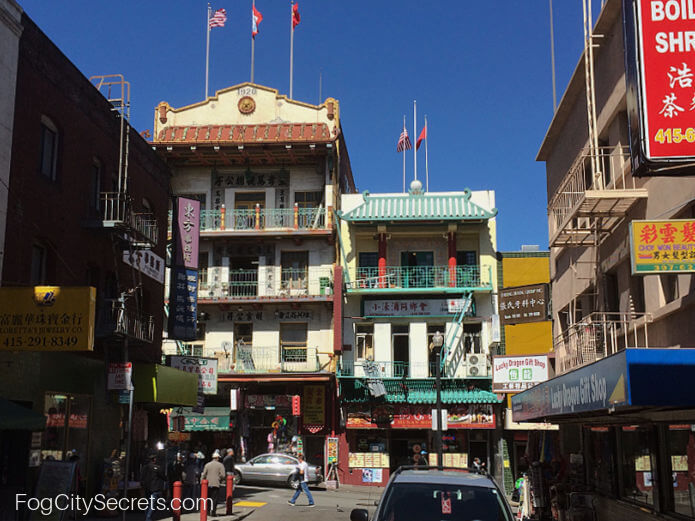 Washington Street
Washington StreetBest Chinatown alleys to check out:
Hang Ah Street (an alley, actually, "Fragrance Alley", named for the perfumeries that used to be there) runs between Sacramento and Clay Streets and has the oldest dim sum restaurant in Chinatown, the Hang Ah Tea Room, one of my favorites.
It's a pleasant place to eat, and the alley is lined with mah jong parlors. More on the Hang Ah Tea Room.
Ross Alley (formerly called "the Street of the Gamblers") is the location of the Fortune Cooke Factory. See below.
Waverly Place, the "Street of the Painted Balconies", is the prettiest of the alleys. See below.
Spofford Alley was once the residence of Dr. Sun Yat Sen, the leader of China's revolution that overthrew the last imperial dynasty in 1911.
He was in hiding from assassins sent by the Manchu rulers and had a secret office at #36 Spofford Street. There is an interesting steel statue of him in St. Mary's Square, on California, between Grant and Kearny.
Some of these alleys were notorious for prostitution (Waverly, Beckett, & St Louis), opium dens (Duncombe), or gambling (Ross).
For information on the history and historical photos of these alleys, see Chinatown alleys.
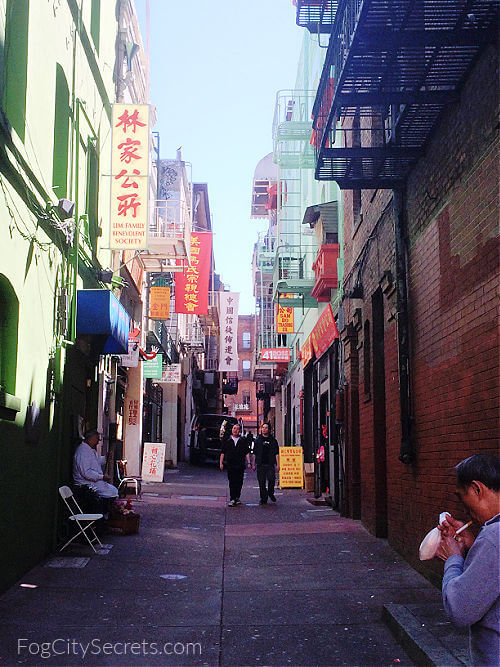 Ross Alley
Ross AlleyMap of Chinatown Alleys
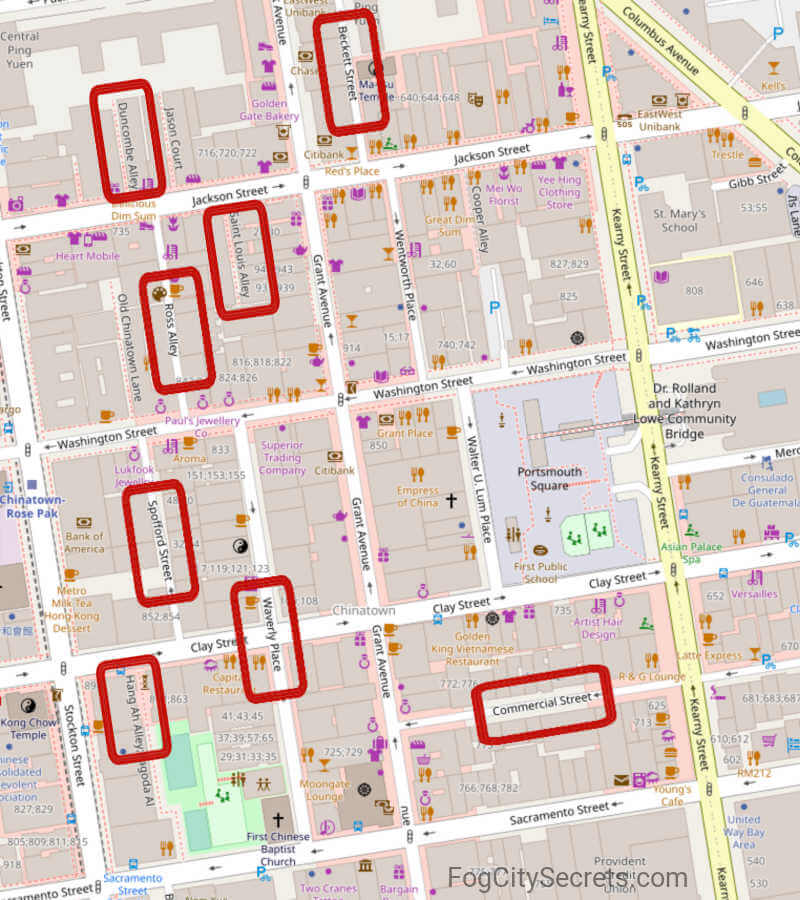
The Golden Gate Fortune Cookie Factory
The Golden Gate Fortune Cookie Factory is in Ross Alley; the little factory has been there making thousands of fortune cookies every day for many years.
It's surprisingly small; several ladies sit at the assembly line and fold and fill the cookies by hand.
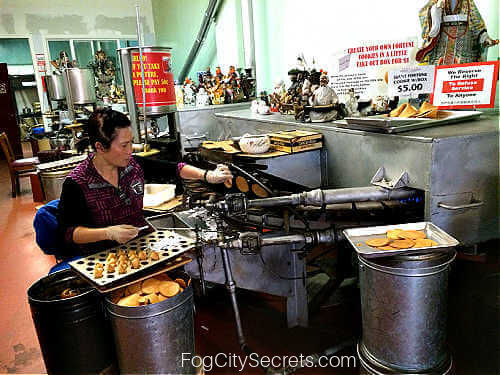 Fortune Cookie Factory
Fortune Cookie FactoryYou can watch them work for free (and may be given a free sample), and you can buy a bag of fresh cookies, but taking a photo will cost you 50 cents. Fun to see!
Ross Alley was also used to film one of the scenes in Indiana Jones and the Temple of Doom.
Located at 56 Ross Alley, just off Jackson Street.
Waverly Place
Waverly Place is a charming, two-block alley with rows of colorful buildings, the "Street of the Painted Balconies".
This street had two of the most famous Chinatown brothels, both run by women (see their stories here).
Also the scene of a major tong war battle over a Chinese slave girl in 1879. The Tin How temple is here.
One of the characters in Amy Tan's Joy Luck Club lived here and was named after the street.
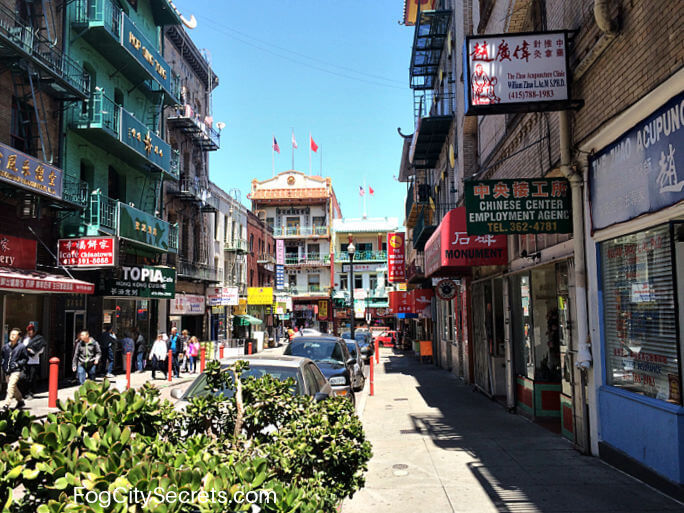 Waverly Place
Waverly PlaceThe Tin How Temple
The Tin How Temple is the oldest Chinese temple in America, founded in 1852. It's on the third floor of 125 Waverly Place (no elevator, street number is kind of hard to see, but it's there) and is open to the public.
The temple is dedicated to the goddess Mazu, the Empress of Heaven (Tin How) who protects seafarers, and has a special place in the hearts of Chinese immigrants.
In addition to a shrine to Tin How, the space is filled with statues of other Chinese deities, and offerings of fruit, with lanterns and candles giving it a warm glow.
They ask that no photos be taken and that worshipers be treated with respect. Free, but a small donation would be nice to leave.
People ask advice at the shrine by shaking fortune sticks and reading the message corresponding to the number of the first stick to fall out. Often the answers are poems that the seeker must interpret.
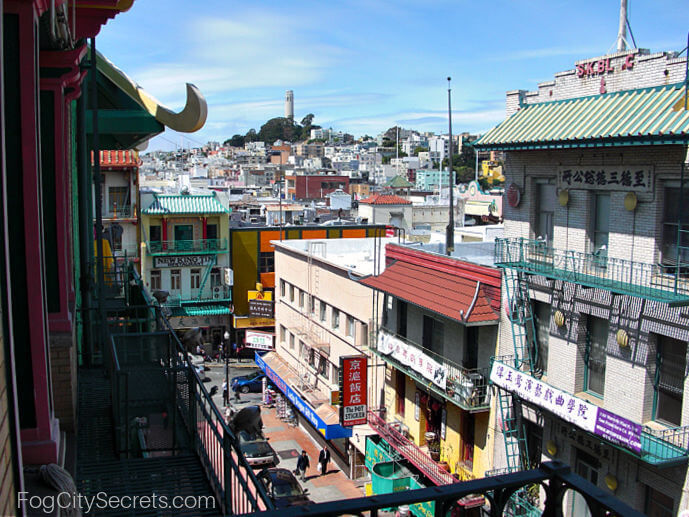 View From Tin How Temple Balcony
View From Tin How Temple BalconyJust Wandering Around
Sometimes the best travel experiences are the unplanned ones.
Chinatown is a great place to meander, heading up this street, or down that alley.
The side streets are less touristy and give more of a feeling of authentic Chinese culture. You really will feel like you're not in the U.S. anymore. And Chinatown is a neighborhood where it's safe to go anywhere.
The man playing the two-stringed instrument in the photo below is the barber Jun Yu, who is sitting outside his small barbershop in Ross Alley.
The instrument is an erhu, also used in classical Chinese orchestras; the violin-like sound is produced by vibration of the snake skin stretched across the sound box.
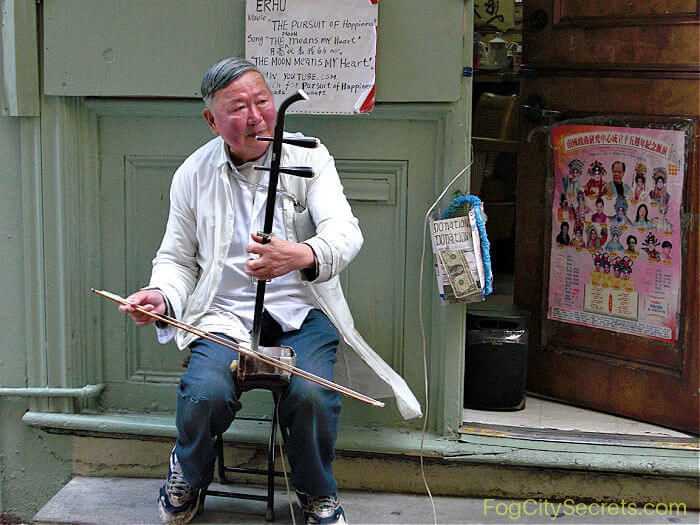 Jun Yu in Ross Alley
Jun Yu in Ross AlleyJun Yu is a bit of a celebrity. He lists Frank Sinatra, and Clint Eastwood as former clients, and played the erhu in the film Pursuit of Happiness (starring Will Smith). He also appeared on The Bachelor in 2010.
Walking Tours of Chinatown
Is it better to take a tour, or explore on your own? The answer depends on one's traveling preferences.
There's a lot of interesting history here, so it can be easier to have someone take you around and tell you the story of a place without having to look it all up yourself and find all those locations.
Popular Walking Tours
Here are a couple of guided tours that have been rated highly by visitors:
Chinatown Walking Tour. This tour takes you through the neighborhood, covering the temples, markets, history, alleyways, fortune cookie factory, and more. There's also an option for a 9-course dim sum lunch. $59, 2 hours.
See Chinatown walking tour for more info and booking.
Chinatown Culinary Tour. This walking tour focuses exploring the back streets of Chinatown, with lots of tastings of authentic Chinese delicacies, exploring Chinese crafts, plus a full lunch. $73.90, 3 hours.
See Chinatown food tour for info and booking.
For more information on walking tours in Chinatown, see my page on the Chinatown tours.
You'll find information on a variety of the Chinatown tours available, including a free guided tour, plus a self-guided walking tour I put together, with a map that you can download and use to head out on your own.
Combine Chinatown with other SF sights.
SF in a Day Tour. This is a full day walking tour, exploring lots of famous San Francisco attractions up close.
Start at the Ferry Building, take a cable car up to Nob Hill, then on to SF City Hall, the Castro district, and the city view from Dolores Park. Next visit the Haight Ashbury, admire the Painted Ladies and walk down Lombard Street. Finish off the tour in the charming Italian North Beach neighborhood and explore Chinatown (including the Fortune Cookie Factory).
Includes cable car tickets. Age 15+. Moderate fitness level. The works, all in one day! $135.
See SF in a Day tour for booking and more info.
Food and Drink
There are over 30 Chinese restaurants in Chinatown! Where are the best places to eat?
Chinatown Dim Sum
Eating dim sum is one of both visitors' and locals' favorite experiences in Chinatown.
If you want authentic dim sum in a truly Chinese setting, stop in at one of these little bakeries.
I've created a list and a map with my recommendations for the best restaurants and dim sum eateries to try out, at Chinatown restaurants.
Li Po Lounge
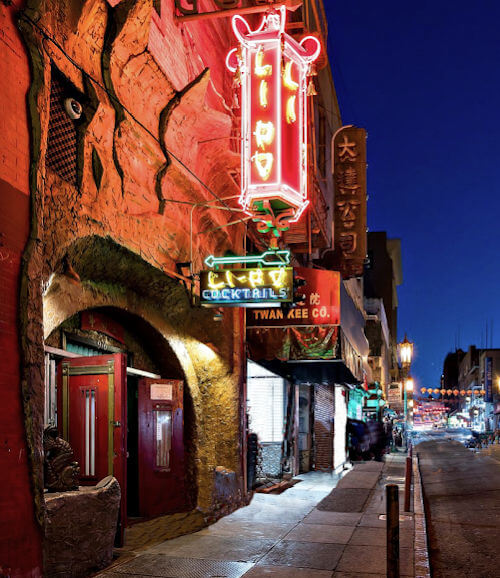 Li Po Lounge at night
Li Po Lounge at nightI have to mention this Chinatown bar. This place started out as a notorious nightclub in the 1930's and has been a local hangout for many years, but it became well-known after it was "discovered" in 2012 by Anthony Bourdain and featured on his travel show.
Looks really seedy on the outside, but is enjoyably tacky and weird inside (and safe).
Imagine that a Tiki Room and a dive bar merged, then throw in lots of Christmas lights and a buddhist shrine, and you have the Li Po Lounge.
It's actually a fun place, and is famous for it's powerful and large Chinese Mai Tai's.
Located at 916 Grant Ave.
The bar is named after Li Po, an 8th century Chinese poet, who wrote many works in praise of alcohol.
Here's one of his most famous poems:
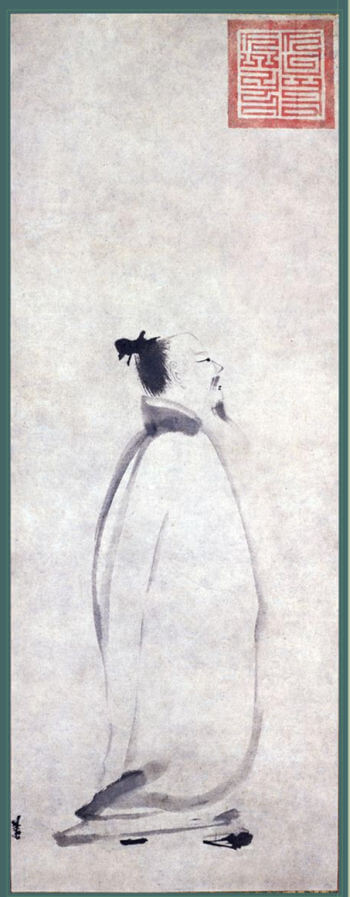 The poet, Li Po
The poet, Li PoAlone and Drinking With the Moon
by Li Po
Amongst the flowers I am alone
with my pot of wine, drinking by myself.
Then lifting my cup I asked the moon to drink with me,
its reflection and mine in the wine cup,
just the three of us.
Then I sigh, for the moon cannot drink, and my shadow goes emptily along with me never saying a word;
with no other friends here, I can but use these two for company.
I sang. The moon encouraged me.
I danced. My shadow tumbled after.
But when I have drunk too much, we all part.
I hope that one day we three will meet again,
deep in the Milky Way.
Chinatown History
Chinatown is where the village of Yerba Buena, later to be San Francisco, started.
Portsmouth Square had the first houses in the city, and Grant Avenue was San Francisco's first street.
Everything changed when gold was discovered in the Sierra foothills in 1849, first publicly announced in Portsmouth Square.
The mad rush to dig for gold brought thousands of men to the port town of San Francisco, including many Chinese, who settled in the streets close to the bay.
What is now Chinatown became a crowded and crime-ridden district for many years, due to a number of factors (too much gold, too few women, corrupt government officials, housing and immigration restrictions on the Chinese, etc.).
And the entire neighborhood was destroyed in the fire that followed the 1906 earthquake.
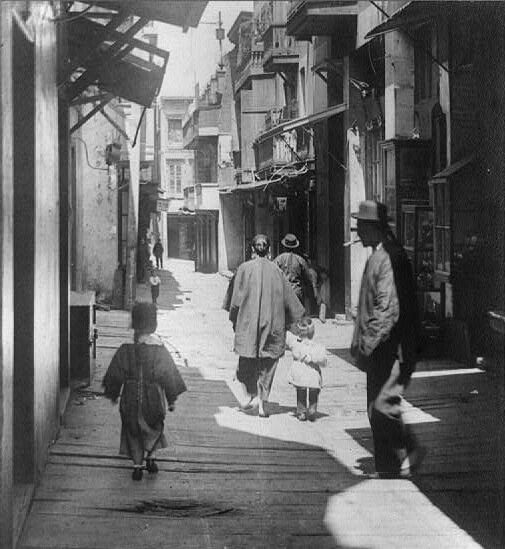 SF Chinatown Alley, Before the 1906 Earthquake
SF Chinatown Alley, Before the 1906 EarthquakeFor a more detailed account of the life in San Francisco's Chinatown during the Gold Rush period, and after, see Chinatown history.
Includes photos from that time period, and the current locations of historic events.
Events in Chinatown
The two main holidays celebrated in San Francisco's Chinatown are Chinese New Year, in January/February, and the Autumn Moon Festival in mid-September.
Chinese New Year is an extremely festive time of year in San Francisco's Chinatown. This year, the Year of the Snake, begins Jan 29, 2025.
There's a massive parade attracting a million viewers, including a street fair and a number of other events, and mountains of fireworks. The Chinese New Year Parade is on Feb 15, 2025.
For more info, see San Francisco's Chinese New Year.
Getting to Chinatown
Chinatown consists of about 24 square blocks, bordered by Kearny, Broadway, Powell and Bush Streets.
The Dragon's Gate entrance to Chinatown is just a couple of blocks from Union Square, where many of the major hotels are located.
Chinatown Bus Lines
The 30-Stockton bus goes right through the heart of Chinatown, right down Stockton Street. You can get off anywhere between Broadway and Bush.
Taking the 30-Stockton bus can be an interesting cultural experience in itself. Be prepared for some pushing and shoving by some determined little Chinese grandmas!
From Fisherman's Wharf, you can catch the 30-Stockton bus along North point Street from Columbus to Van Ness.
You can also catch the 30-Stockton near Union Square at Sutter and Stockton.
See the bus route (click "live" tab or download the pdf) go to 30-Stockton.
New Muni Streetcar Line
Chinatown acquired its first stop on San Francisco's subway system two years ago.
Yes, SF sort of has a subway system. See getting around in SF.
An extension to the T-Third St line connects Chinatown with the underground Muni lines, with the new stop at Stockton and Washington Streets, the Rose Pak Station.
It's the deepest of the underground stations in San Francisco; attractive and clean, so far.
To switch from the lines running under Market Street to this one, get off at the Powell Street station, and follow the signs underground to the T-line.
Or come up above ground and walk over to Stockton and O'Farrell St, a couple of blocks away, and go back underground there and catch it at the Union Square/Market Street Station.
Cable Cars
All three cable car lines go through (or near) Chinatown as well.
The California Street line stops at Grant Avenue, the main street of Chinatown.
On the two Powell Street lines, get off on Powell Street anywhere between Bush and Jackson, walk downhill one block and you will be on Stockton Street in Chinatown.
See cable cars for tips on riding them, and where to catch them.
Walk from Union Square
If you are staying in Union Square, or shopping there, you can easily walk to Chinatown from there.
One side of the square is Stockton Street, which runs right into Chinatown two blocks later.
Go left up Stockton two blocks, then walk one block right on Bush Street, and you will be at the Dragon's Gate entrance to Chinatown. See map below.
Map of Chinatown
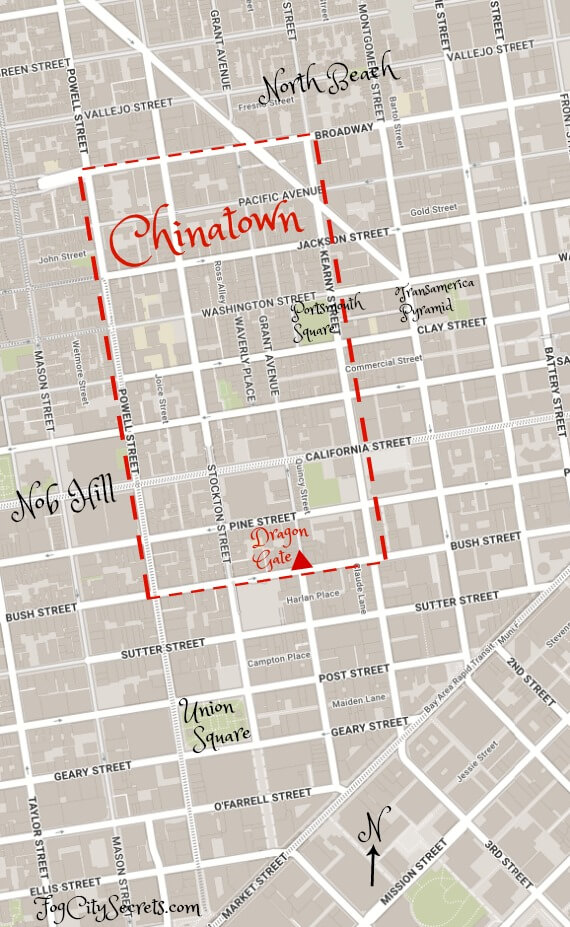
Chinatown Parking
Street parking is tough here; I don't attempt it myself. But there are two decent parking garages in the neighborhood.
Portsmouth Square Garage
This one is my favorite garage, where I usually park.
It's right in the center of things, has lots of room, and isn't outrageously priced. $3 per hour. Open 24 hrs.
They take some restaurant validations after 5 p.m. When it starts to get filled up, they do valet parking. Entrance at 733 Kearny St.
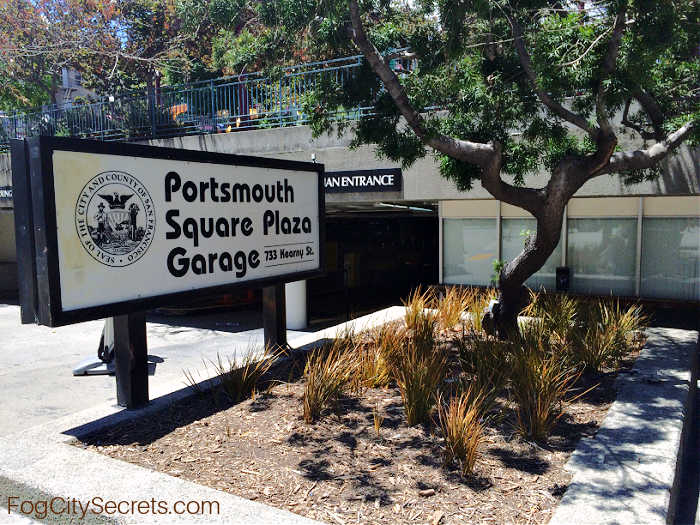
Tip: the garage is surrounded by one way streets and the traffic is pretty congested there.
The easiest approach is to come down Clay Street in the left lane and turn left onto Kearny to get into the line for the garage entrance on Kearny.
When you exit the garage, stay on Kearny St. Don't turn onto Washington Street; you'll run into a traffic mess.
They have cool names for the garage floors and sections: e.g. The Dragon Floor (3), with Wisdom, Growth and Power sections.
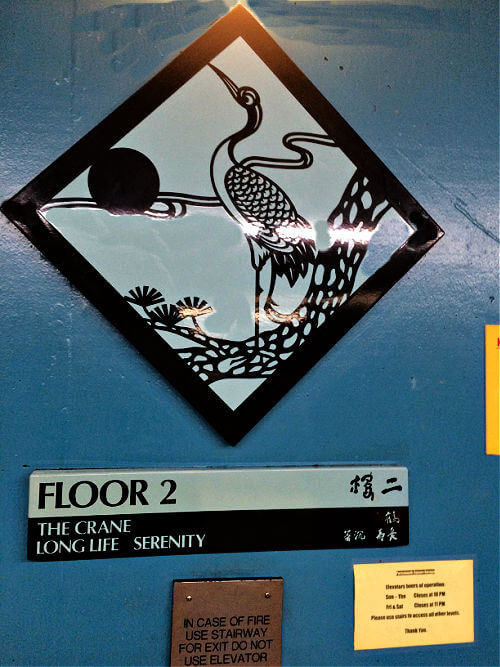 Portsmouth Square Garage
Portsmouth Square GarageSt. Mary's Square Garage
A bit more expensive, but still very convenient, just off Grant Avenue with an entrance on California, and another at 433 Kearny Street.
$3.50 to $4.50 per hour, $1 hourly after 6 p.m. Open 24 hrs.
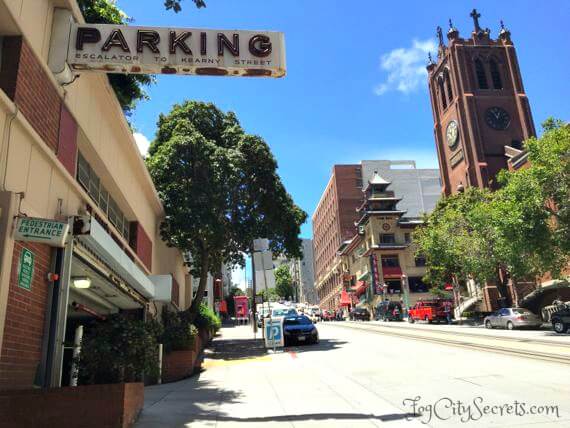 St. Mary's Square Garage,
California St. Entrance
St. Mary's Square Garage,
California St. EntranceHotels near Chinatown
If you want to stay near Chinatown, there are several hotels in the area that I would recommend.
They all have good ratings and are conveniently located.
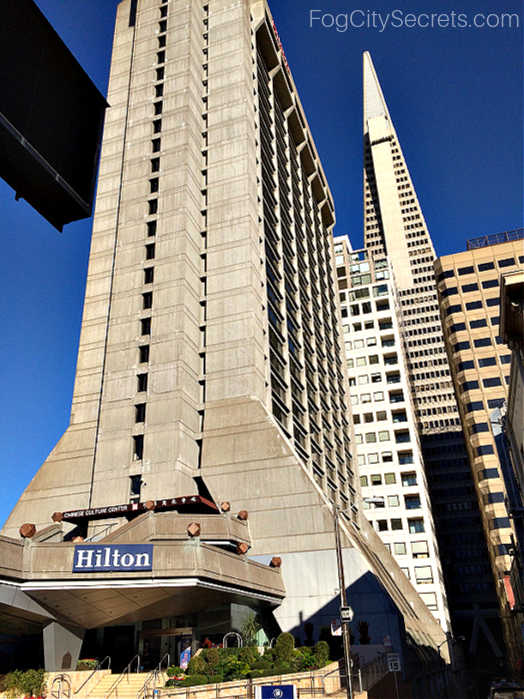
The San Francisco Financial District Hilton is just across the street from Portsmouth Square, the heart of Chinatown. Plus it's right next to the Transamerica Building and the Financial District. Great city views from the higher rooms. Reasonable prices for SF. 750 Kearny Street.
See Financial District Hilton for more info, reviews and booking.
The Orchard Garden Hotel is next to the entrance to Chinatown, at the Dragon Gate. Close to Union Square shopping and restaurants as well. 466 Bush Street.
See Orchard Garden for more info, reviews and booking.
The SW Hotel is right in Chinatown and next door to the Italian neighborhood of North Beach. Coit Tower is close by also. 615 Broadway.
See SW Hotel for info, reviews and booking.
For more choices, see Chinatown hotels on booking.com.
Or look at my article on the best areas to stay in San Francisco.
Chinatown FAQ
- What hours is Chinatown open? Chinatown itself is always open; the streets of Chinatown are public streets. Most of the businesses are open daily, as are the restaurants. Hours vary, but most restaurants are open for lunch and dinner/evening hours, some earlier. Check individual businesses.
- Do the cable cars go to Chinatown? Yes, the California Line stops on Grant Avenue, and the other two lines take you within one block of Chinatown.
- Is it safe to visit Chinatown? Generally speaking, yes. Unfortunately, there have been a series of recent daytime robberies of Chinatown residents but it appears that tourists weren't targeted. You can wander around and even explore the alleys without much risk. Chinatown is still one of the safer areas of the city.
- Can you stay in Chinatown? Yes, there are a number of hotels in and near Chinatown that are rated highly and would generally be safe to stay in. See list above.
More to explore...
Share this page:
